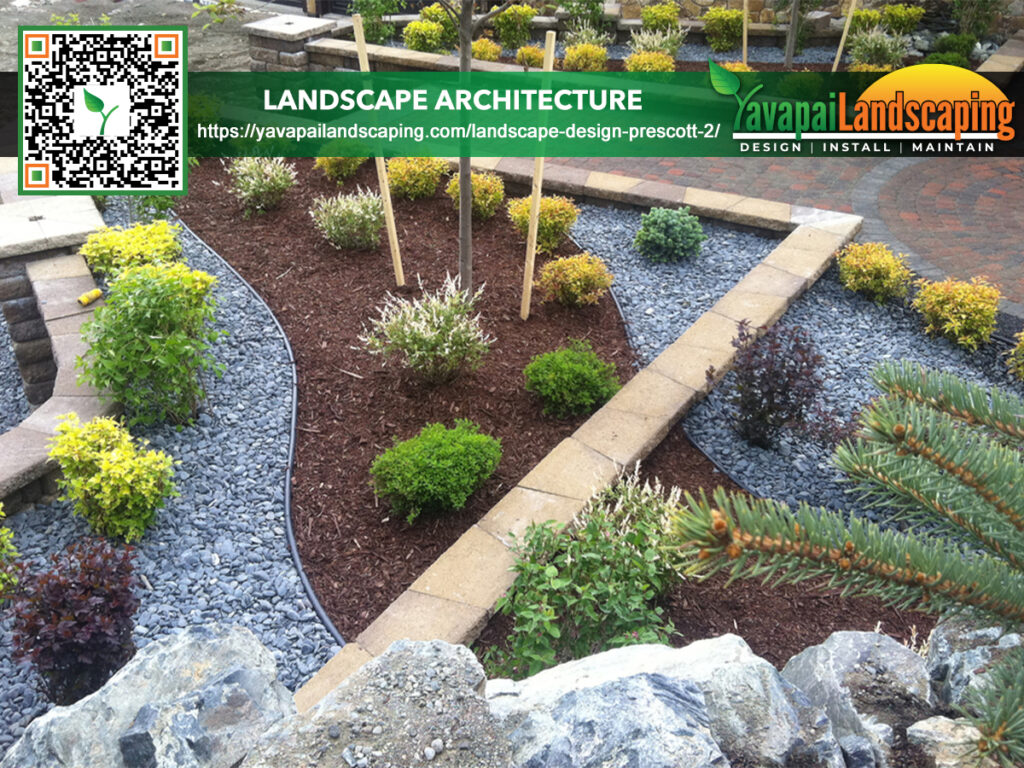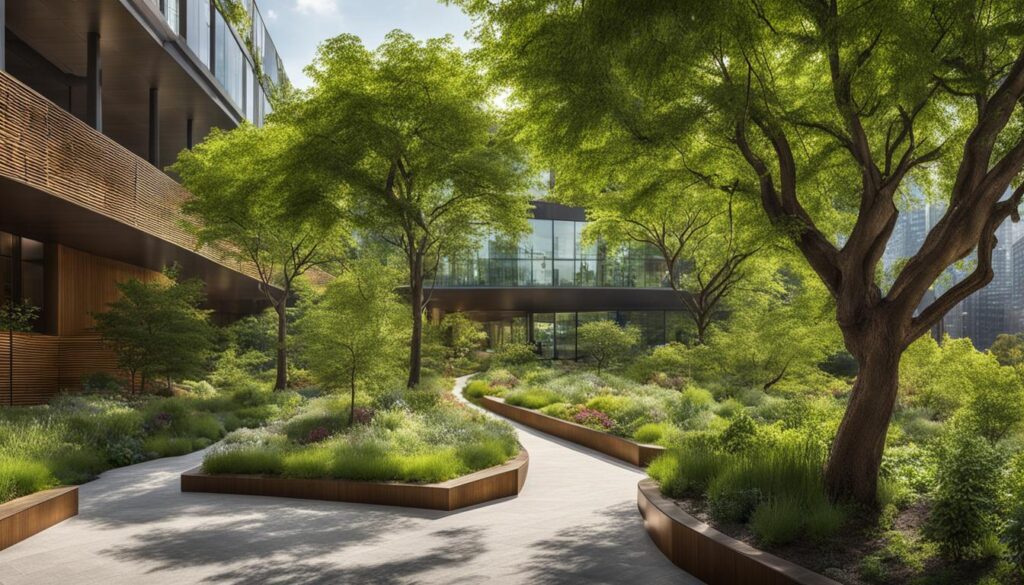
The future of sustainable landscape architecture looks promising with innovative techniques and responsible design strategies taking center stage. From case studies around the world, including Staten Island’s Living Breakwaters and Shanghai’s Quarry Garden, we can see the transformative effects of sustainable design. These projects showcase the potential for environmentally friendly landscaping and highlight the importance of nature-based solutions and green infrastructure in creating sustainable urban spaces.
Key Takeaways:
- The future of sustainable landscape architecture is focused on innovative techniques and responsible design strategies.
- Case studies demonstrate the positive impact of sustainable landscape design on communities and the environment.
- Incorporating nature-based solutions and green infrastructure is essential for creating sustainable urban spaces.
- Responsible design strategies prioritize the use of sustainable materials, energy-efficient practices, and green construction methods.
- Sustainable urban planning and site design play a crucial role in creating livable and eco-friendly cities.
Innovative Techniques in Sustainable Landscape Architecture
Sustainable landscape architecture is continually evolving with the emergence of innovative techniques that prioritize environmental sustainability and resilience. By incorporating these techniques, landscape architects can create spaces that are not only aesthetically pleasing but also contribute to the long-term health of the planet. This section explores some of the most groundbreaking and forward-thinking techniques in sustainable landscape architecture today.
Green Roofs
One innovative technique gaining popularity in sustainable landscape architecture is the use of green roofs. These roofs are covered with living vegetation, providing numerous environmental benefits. Green roofs help reduce stormwater runoff by absorbing rainwater, improve air quality by trapping pollutants, and enhance energy efficiency by insulating buildings. They also create habitats for wildlife, contribute to urban heat island mitigation, and increase the overall beauty and biodiversity of urban areas.
Drought-Tolerant Planting
In regions prone to water scarcity, drought-tolerant planting is a valuable technique that conserves water while maintaining visually appealing landscapes. By selecting and incorporating plant species that are naturally adapted to arid conditions, landscape architects can create vibrant and sustainable environments that thrive in dry climates. Drought-tolerant plants require less irrigation, reducing the demand for water resources and promoting water conservation.
Permeable Pavement
Permeable pavement is another innovative technique that addresses stormwater management challenges. Unlike traditional impervious paving surfaces, permeable pavement allows water to infiltrate through the surface, reducing stormwater runoff and promoting groundwater recharge. This technique helps mitigate flooding, prevent soil erosion, and improve water quality by filtering out pollutants. Permeable pavement is particularly beneficial in urban areas where impervious surfaces dominate the landscape. Gain deeper insights into Urban Garden Magic: Discover The Key Principles Of Landscape Design to Elevate Your Small Space.
| Technique | Benefits |
|---|---|
| Green Roofs | Reduces stormwater runoff, improves air quality, enhances energy efficiency |
| Drought-Tolerant Planting | Conserves water, creates visually appealing and sustainable landscapes |
| Permeable Pavement | Addresses stormwater management challenges, mitigates flooding, improves water quality |
Responsible Design Strategies for Green Spaces

In the future of sustainable landscape architecture, responsible design strategies for green spaces play a crucial role. These strategies prioritize the use of sustainable materials, energy-efficient practices, and green infrastructure, ensuring that landscape architecture minimizes its environmental impact.
One example of a responsible design strategy is the use of native plants. Native plants are well-adapted to the local climate and require less water and maintenance compared to non-native species. By incorporating native plants into green spaces, landscape architects can create vibrant, biodiverse habitats while reducing the need for excessive irrigation and chemical inputs.
Efficient irrigation systems are also essential for responsible design. Technologies such as drip irrigation and smart controllers help optimize water usage by delivering water directly to the plant roots and adjusting watering schedules based on weather conditions. These systems minimize water waste and promote water conservation in green spaces.
| Responsible Design Strategies for Green Spaces | Benefits |
|---|---|
| Use of native plants | Promotes biodiversity and reduces water consumption |
| Efficient irrigation systems | Minimizes water waste and promotes water conservation |
| Sustainable construction methods | Reduces resource consumption and waste generation |
Sustainable construction methods are another important aspect of responsible design. By using eco-friendly materials and implementing construction practices that reduce resource consumption and waste generation, landscape architects can minimize the environmental impact of their projects.
By adopting these responsible design strategies, green spaces can be transformed into environmentally conscious havens that benefit both humans and the planet. They provide habitats for wildlife, contribute to cleaner air and water, and create beautiful and functional spaces for people to enjoy. Explore and understand more about How Landscape Design Services Enhance the Aesthetics of Your Home.
Sustainable Urban Planning and Site Design
Sustainable urban planning and site design are essential components of creating environmentally conscious and livable cities. These approaches prioritize the integration of sustainable practices, green spaces, and efficient infrastructure to foster a harmonious relationship between urban areas and the natural environment.
The Benefits of Sustainable Urban Planning
Sustainable urban planning offers numerous benefits, both for the environment and the community. By incorporating elements like walkability, bike lanes, and public transportation systems, cities can reduce reliance on cars and promote a healthier, more active lifestyle for residents. Additionally, sustainable urban planning emphasizes the preservation and enhancement of green spaces, such as parks and community gardens, which not only provide recreational opportunities but also improve air quality and support biodiversity.
The Importance of Sustainable Site Design
Sustainable site design takes a holistic approach to creating environmentally friendly spaces. It considers factors such as site orientation, water management, and the use of sustainable materials to minimize energy consumption and reduce waste. By implementing green infrastructure, such as rain gardens and permeable pavements, cities can mitigate the impacts of stormwater runoff and improve water quality. Sustainable site design also integrates innovative technologies, like smart grids and renewable energy systems, to promote energy efficiency and reduce carbon emissions.
Nature-Based Solutions for Climate Change Adaptation
Nature-based solutions are becoming increasingly important in the field of sustainable landscape architecture, particularly in the context of climate change adaptation. These solutions harness the power of nature to mitigate the impacts of climate change, such as flooding, heat waves, and water scarcity. By using natural systems and resilient design principles, landscape architects can create sustainable and adaptive landscapes that not only protect communities but also enhance biodiversity and ecosystem services.
Another compelling case study is the Transformative Water project in Pitkin County, Colorado. This initiative focuses on restoring river habitats and improving water quality by incorporating natural floodplain features and using innovative water management strategies. The project not only enhances the resilience of the landscape but also provides recreational opportunities and improves the overall quality of life for residents. Through a combination of nature-based design and community engagement, the Transformative Water project showcases the transformative potential of sustainable landscape architecture in the face of climate change.
Conclusion
The future of sustainable landscape architecture is bright! With a focus on transforming urban spaces, embracing innovative techniques, and implementing responsible design strategies, landscape architects have the opportunity to create sustainable, resilient, and beautiful spaces that contribute to a greener future.
In conclusion, sustainable landscape architecture holds the key to creating a more sustainable and livable future. By prioritizing green infrastructure, embracing innovative techniques, and implementing responsible design strategies, landscape architects can contribute to a greener world while creating aesthetically pleasing and environmentally conscious spaces.
Yavapai Landscaping Prescott offers installation and maintenance services for both new and existing homes. We provide a full range of landscape services, including paver driveways, walkways, patios, outdoor kitchens, fire pits, synthetic turf, sod, decorative rock, ponds, water features, irrigation, drip systems, backflow devices, erosion control, rip-rap, and drainage swales. We also offer recurring maintenance, snow removal, brush removal, fire wise, and defensible space services.
FAQ
What is sustainable landscape architecture?
Sustainable landscape architecture involves designing outdoor spaces that are environmentally friendly and reduce the negative impact on the planet. It incorporates strategies like green infrastructure, nature-based solutions, and responsible design practices to create sustainable and resilient landscapes.
What are responsible design strategies for green spaces?
Responsible design strategies for green spaces involve incorporating sustainable materials, energy-efficient practices, and green infrastructure. Projects like Sherbourne Common in Toronto and the High Line Park in New York City prioritize the use of native plants, efficient irrigation systems, and sustainable construction methods to minimize the environmental impact of landscape architecture.
How does sustainable urban planning and site design contribute to landscape architecture?
Sustainable urban planning and site design integrate sustainable principles like walkability, public transportation, and green spaces into urban development. Projects like the California Institute of Technology Master Plan in Pasadena and the Park 20/20 in the Netherlands showcase the importance of creating sustainable and livable urban environments through responsible design practices.
What are nature-based solutions for climate change adaptation?
Nature-based solutions for climate change adaptation utilize natural systems and resilient design principles to mitigate the impacts of climate change. Projects like the Crosswaters Ecolodge in China and the Transformative Water in Pitkin County, Colorado, demonstrate how nature-based design strategies can address issues like flooding and water scarcity.











